
This campaign focused on the solar eclipse that graced the skies above North America on April 8, 2024. This event offered ideal conditions for eclipse science, unique opportunities for cross-disciplinary collaborations, and an excellent occasion for public engagement. Efforts ranged from measuring the emission of the solar corona to quantifying the response of Earth’s different atmospheric layers and engaging citizen scientists in tracking the eclipse across the US.
For more information on how to get involved check this announcement. If you have any questions, are interested in participating in the campaign, or notice that something is missing please contact us at whpi_help@hao.ucar.edu.
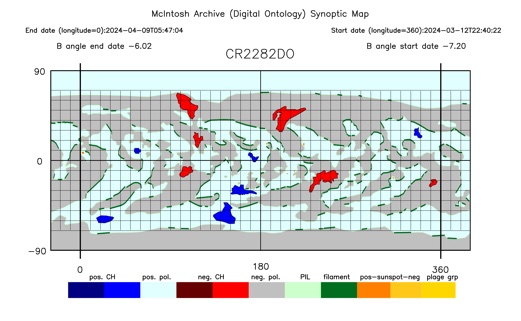
The list below aims to serve as a repository for existing or ongoing eclipse activities and foster collaboration across disciplines. The efforts are grouped by activity type. The list is not exhaustive and is being updated as we are made aware of different activities (See the most up-to-date list).
Type: Eclipse Model Predictions | Planned Eclipse Observations | Science Experiments | Citizen Science Projects | Education & Outreach
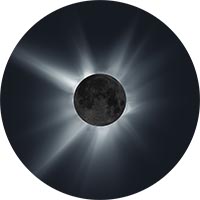
Contact: Cooper Downs
Institution: Predictive Science Inc.
We will use a magnetohydrodynamic (MHD) model of the solar corona to predict the appearance of the April 8, 2024, total solar eclipse. The model incorporates non-ideal thermodynamic transport terms and employs a wave-turbulence-driven (WTD) description of coronal heating and solar wind acceleration. Our previous coronal predictions employed relaxed MHD solutions corresponding to a boundary condition based on a single photospheric magnetic map, incorporating data that at best was measured 10 to 14 days prior to the eclipse. This year, we introduce a new paradigm: A continuously updated prediction based on a time-evolving model. To accomplish this near-real time description, we have incorporated 3 new elements: (1) a time-evolving MHD model driven by evolution of the photospheric magnetic field, (2) an automated method for energizing the non-potential corona near polarity inversion lines that evolve in time, and (3) A tailored approach for assimilating near-real time surface magnetic field observations such that any artifacts introduced have a minimal impact on the coronal solution and can be used to incorporate low-latency observations from the Solar Orbiter PHI instrument made away from the Sun–-Earth line.
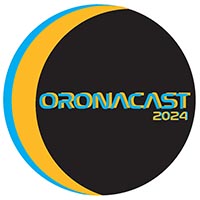
Contact: Daniel Welling
Institution: Climate and Space Sciences and Engineering, University of Michigan
We are a graduate student-team consisting of University of Michigan and University of Texas at Arlington students using the Space Weather Modeling Framework (SWMF) and its Alfven Wave Solar-Atmosphere Model - Realtime (AWSoM-R) to simulate the solar corona ahead of and during the eclipse. Using HipFT, the High-performance Flux Transport code from Predictive Science Inc and magnetic field predictions from LMSAL, we are using the forecasted photospheric magnetic field and using AWSoM-R to predict the 3D plasma properties and emission. We also predict the ionospheric-thermospheric response to the totality. Our products are line intensities and line profiles, line widths, doppler shifts as proposed to be measured by individual instruments, and line of sight full disk images (EUV, X-ray, and White Light). The week leading to the eclipse we will run the CoronaCast Prediction Center from Arlington, Tx with updated models leading up to the eclipse. And will be partnering with Arlington Independent School District for outreach events with local middle and high school students. We will also be livestreaming through University of Michigan Climate and Space Youtube page during the eclipse (April 8th).
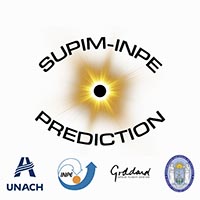
Contacts: Manuel Bravo1, Jonas de Souza2, Miguel Martínez-Ledesma3, Blas de Haro Barbás4
Institutions: 1. Centro de Instrumentación Científica, Universidad Adventista de Chile, 2. Instituto Nacional de Pesquisas Espaciais, 3. Geospace Physics Laboratory - NASA Goddard Space Flight Center, 4. Universidad Nacional de Tucumán
After the good results obtained by the SUPIM-INPE model simulations of the ionospheric response to the total solar eclipses of July 2, 2019 and December 14, 2020 over South America, we have made a prediction of the eclipse effects of April 8, 2024 on the ionosphere. We provide simulation results that can be directly compared to future measurements obtained at North American ionospheric stations during this eclipse. In particular, we have evaluated the predicted ionospheric response for Millstone Hill (USA), Boulder (USA), Ramey (Puerto Rico), and Mexart (Mexico) stations. Additionally, we can provide predictions for any other geographic point if necessary. We encourage the scientific community to compare their measurements with our simulation results.
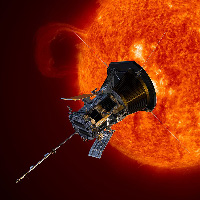
Contacts: Manolis Georgoulis, Sam Badman, Pete Riley
Institutions: Johns Hopkins University APL; Center for Astrophysics - Harvard & Smithsonian; Predictive Science Inc.
Magnetic footpoint predictions for Parker Solar Probe's 19th perihelion prior to the eclipse will be issued from March 29 - April 2 (now!). These predictions will include an identification of a source region that will subsequently be on the solar western limb during the eclipse. Please contact manolis.georgoulis@jhuapl.edu to receive email updates as these predictions are issued - they will be also available at the WHPI PSP 19 campaign. For more information on the successive encounters of the mission, please see the PSP Science Planning.
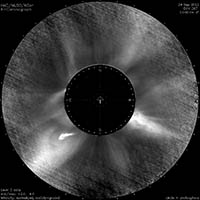
Contacts: Joan Burkepile, Ben Berkey
Institution: High Altitude Observatory NSF NCAR
Nominal observing time: 17:30 to ~21:30 UTC
UCoMP instrument:
1) Cross-calibration of Fe XIII with other experiments: [1074 nm-7pts, 1079 nm-7pts, 1074 nm-7pts, 1079 nm-7pts]
2) Waves [1074-3pts 30 second cadence] program to produce plane of sky magnetic field maps, and polarization maps
3) Emission lines: Fe X 637-5pts, Fe XV 706-5pts, Fe XI 789-5pts]
4) Repeat 1 and 3 above 5) S XII at 761 nm; S VIII at 991 nm, Ni XV 670 nm, Ni XV 802 nm 3pts
K-Cor instrument: 15 sec cadence polarization brightness
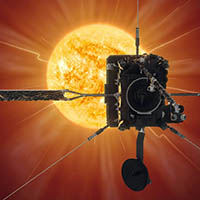
Contacts: Chris Nelson, Miho Janvier
Institution: ESA Solar Orbiter team
Solar Orbiter will be in a position close to quadrature with the Earth during the April 2024 solar eclipse. Throughout the eclipse, the remote-sensing instruments on-board will be conducting a SOOP called ‘Eruption Watch’, with the primary aim of sampling the plasma of the solar corona out to distances of 3.1 solar radii (including the Sun-Earth line due to the position of Solar Orbiter). For 100 minutes around the totality of the eclipse, the Extreme Ultraviolet Imager (EUI) instrument will use its High-Resolution Imager (HRI) camera to sample the million-degree plasma within the solar corona close to the West limb of the Sun, as observed from Earth.
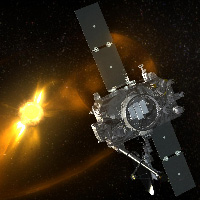
Contact: Angelos Vourlidas
Institution: Johns Hopkins University APL
STEREO is planning a high telemetry campaign for SECCHI/Cor2 and HI1 instruments. The current plan is:
April 1-6: COR2 2.5-min + HI1 20-min
April 7-9: COR2 pB 5-min program
April 10: COR2 regular synoptic + 20-min HI1
April 11-15: COR2 2.5-min + HI1 20-min
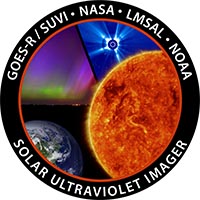
Contact: Christian Bethge
Institution: Cooperative Institute for Research in Environmental Sciences
GOES-18/SUVI will be observing in its Extended Coronal Imaging (ECI) mode. Observations are carried out in the 171 Å and 195 Å channels of the instrument. Mosaics are constructed from Sun-centered images (single 10-s exposure) and off-pointed images (pixel-by-pixel medians of five 17-s exposures) for a total field-of-view up to about 8 solar radii. The cadence for each mosaic is about 11 minutes.
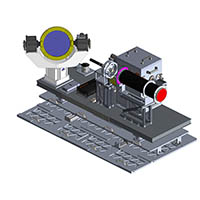
Contact: Jenna Samra
Institution: Center for Astrophysics - Harvard & Smithsonian
The Airborne Coronal Emission Surveyor (ACES) is a new imaging Fourier transform spectrometer that will explore the large-scale coronal infrared (IR) emission spectrum during the April 8, 2024 total solar eclipse. ACES will fly at an altitude of 45,000 feet altitude on the NSF/NCAR Gulfstream V, above most of the IR-absorbing atmosphere. During the six-minute total eclipse, ACES will map emission line intensity in the 1–4 μm wavelength region over a 2000 x 100 arcsecond field of view, searching for lines that may be viable candidates for measuring the coronal magnetic field and plasma diagnostics at large solar radii.
Contact: Bharat Kunduri
Institution: Virginia Polytechnic Institute & State University
The observational campaign will deploy a Digisonde at the Wright-Patterson Air Force Base and another ionospheric sounder (developed by collaborators at JHUAPL) will be flown on the WB-57 aircraft, along the path of totality. The Digisonde at the Wright-Patterson Air Force Base is located in the path of totality and also in the fields-of-view of two Super Dual Auroral Radar Network (SuperDARN) radars. Collectively, measurements from the ionospheric sounders and several SuperDARN radars will provide crucial details about the impact of the eclipse on the ionosphere-thermosphere system.

Contact: Momchil Molnar
Institution: High Altitude Observatory NSF NCAR
The Coronal HElium Emission Spectrograph Experiment (CHEESE) is going to measure the near infrared spectrum of the solar corona during the eclipse on April 8th. CHEESE is going to observe the spectral range between the Fe XIII 1074/1079 nm lines and the He I 1083 nm line with spectral resolution of R~10,000. The main goal of the experiment is to constrain the abundance of neutral helium in the solar corona, which is an important ingredient for Hanle effect-based coronal magnetometry.
Contact: Alin Paraschiv
Institutions: National Solar Observatory; High Altitude Observatory
The FeSun experiment will observe the infrared Fe XIII corona during totality. The joint HAO/NSO observation will mosaic the entire disc via filtergram snapshots of the inner corona. Our small experiment can tentatively sample the Fe XIII lines up to heights of 1.3 Sun radius. We aim to capture both lines near-simultaneously at as many distinct spacial locations to gather a statistically significant data-point sample. An extended objective is to separate the samples into distinct AR, CH, or Streamer distributions. The experiment will further constrain the theoretical interpretation of the Fe XIII lines and determine the local plasma density.
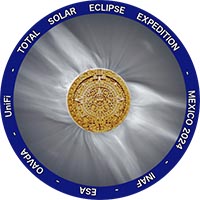
Contact: Lucia Abbo
Institution: INAF - Astrophysical Observatory of Turin
The scientific observational campaign at Torreon (Mexico) will bring three instruments: one telescope for observations of the K-solar corona (E-KPol); two telescope for spectro-polarimetric observations of Fe XIV at 530.3 nm and He I D3 at 587.6 nm coronal lines (E-CorMag and Strato-CorMag). The spectro-polarimetry of Fe XIV and He I D3 lines offers the unique opportunity to study the magnetic topology.
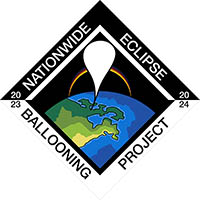
Contacts: Angela Des Jardins, Nationwide Eclipse Ballooning Project
Institution: Montana State University
NEBP, a NASA Science Activation project, involves 1,000 students and mentors from across the country in a NASA-mission-like adventure in data acquisition and analysis through scientific ballooning. Engineering teams use innovative larger balloon systems to live stream video, observe in situ perturbations in atmospheric phenomena, and conduct individually designed experiments. Atmospheric Science teams fly weather sensors every hour for 24 hours prior to eclipses and 6 hours after to provide data that enables analysis of the atmospheric response to the cold, dark shadow of eclipses.
Contact: S. Krishna Prasad
Institution: Aryabhatta Research Institute of Observational Sciences
ARIES plans to carry a single refracting Vixen telescope to image the Sun using a narrowband green line filter (Fe XIV 530.3 nm). The goal is to study the high-frequency dynamics within the inner corona.
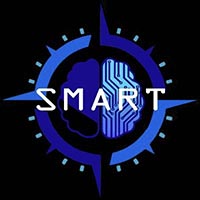
Contact: Peter Chi
Institution: Department of Earth, Planetary, and Space Sciences, UCLA
The SMART project is coordinating an geomagnetic field observation campaign for the April 8, 2024 total solar eclipse with partner networks in the continental United States and high schools along the path of totality.

Contact: Andy Meade
Institution: Texas A&M University-Corpus Christi
We will be launching custom-made weather balloon payloads that include relatively inexpensive microsensors such as Pico environmental sensors (which include UV, light, etc.), a BME280 sensor, and a SDS011 PM2.5 (PM 10). We will have attached a radiosonde for tracking and measuring atmospheric properties as well. We will also be measuring ozone (O3) and carbon monoxide (CO), along with calibrated ozonesondes provided by Saint Edwards University in Austin, TX. We will have four ground weather stations within the area that will be measuring other atmospheric properties as well as the electric field using CS110's during the allocated time of the eclipse. The general objective of the project is to provide educational experiences to undergraduate students at Texas A&M University-Corpus Christi to get hands-on experience on launching the balloon payloads and get experience on the field with our custom-made payloads and weather instrumentation.
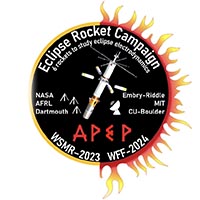
Contact: Aroh Barjatya
Institution: Embry-Riddle Aeronautical University
APEP is an eclipse rocket campaign that launched 3 rockets from White Sands Missile Range during the Oct 2023 annular eclipse, and will launch 3 rockets from the Wallops Flight Facility during the April 2024 total eclipse. This campaign will be the first simultaneous multipoint spatio-temporal in-situ observations of electrodynamics and neutral dynamics associated with solar eclipses in the mesosphere-lower-thermosphere region. For each eclipse, the first of the three instrumented rockets will be launched 35-45 minutes before peak local eclipse, the second at peak local eclipse, and the third 35-45 minutes after peak local eclipse. The launches will be supported by comprehensive ground-based observations through digisondes, meter wind radar, ISR, as well as high-altitude balloon launches to see meteorological forcing from below Observations will be used to constrain comprehensive modeling during data analysis.
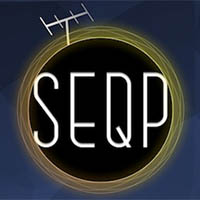
Contact: Nathaniel Frissell
Institution: University of Scranton
Hundreds of amateur (ham) radio operators will be using their stations to contact one another over a 10 hour period: Before, during and after the eclipse. Their transmissions will be recorded by automated ’spotting’ networks, eventually totaling millions of data records. Those records, upon analysis, should reveal eclipse induced effects on the bottom side of the ionosphere, such as changes in height and in its ability to refract radio signals.
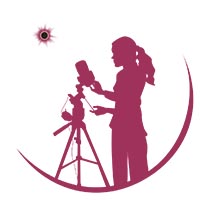
Contact: Hannah Hellman
Institutions: Sonoma State University; UC Berkeley
The Eclipse Megamovie Project aims to add a new dimension to our existing studies of the Sun’s faint atmosphere, the inner corona. By stitching together thousands of images taken along the path of the 2017 total solar eclipse, we have already created a unique treasure-trove of information on how the corona changes over time. Radio-wave studies have allowed us to closely observe very rapid variations of the corona, but now we expect to study such processes directly using visible light and thus enrich our knowledge of the Sun’s dynamic atmosphere considerably. The data gathered via the Eclipse Megamovie Project will be made available publicly and are expected to allow scientists to analyze the Sun’s corona for many years to come. This will show how the Sun changes over a few hours, but also how it’s different after a period of seven years. The high-resolution processed images may also be shared with fellow solar eclipse researchers to incorporate into their own endeavors if desired, such as the work published by Pasachoff and Rušin in 2022 to understand the evolution of magnetic fields.
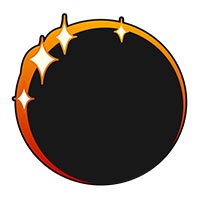
Contact: Hugh Hudson
Institution: University of Glasgow
The SunSketcher.org project provides a free app to allow smartphone users to help capture the precise timing of Baily's Beads. This will define the detailed shape of the solar disc by using the Moon as an astrometric reference, and it benefits from massive oversampling. The app runs automatically and uploads its images to a central server; all the user has to do is aim the back camera approximately towards the Sun a few minutes before second contact, and after the eclipse to approve of the upload.
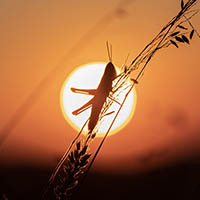
Contact: Henry Winter
Institution: ARISA Lab
Will animals and insects respond when the eclipse darkens the skies on April 8, 2024? This accessible and inclusive participatory science project invites the public to experience the eclipse in a multisensory manner by collecting audio data and sensory observations.
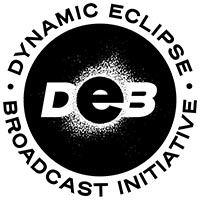
Contact: Bob Baer
Institution: Southern Illinois University
A citizen science project that is placing 80+ teams both inside and outside the path of totality across all of North America. Teams collect white light images that will allow for the study of the inner corona. These images will be broadcast in near real-time during the eclipse and then later stitched together to create a movie showing coronal evolution.
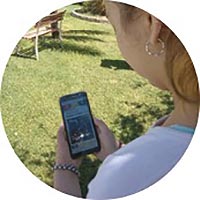
Contact: Kristen Weaver
Institution: NASA Goddard Space Flight Center
Use the GLOBE Eclipse tool as part of GLOBE Observer, app of The GLOBE Program, and a simple thermometer to observe how the eclipse changes atmospheric conditions near you by reporting on clouds and air temperature. We also ask participants to report on surface conditions (photograph and describe the landscape) that may have an impact on differences in the atmospheric effects in varying locations. Through the project, you will be contributing to a citizen science database used by scientists and students to study the effects of eclipses on the atmosphere. We are looking for comparison data from anywhere experiencing the eclipse, even if you are not within the path of totality.
Contact: David Kazdan
Institution: Case Western Reserve University
The Case Amateur Radio Club W8EDU and HamSCI are soliciting volunteers to monitor the National Research Council Canada shortwave transmitter CHU in Ottawa, Ontario. The eclipse path approximates the great-circle from Toronto, Ontario to Austin, Texas and continues to Ottawa, representing a unique opportunity to find the propagation "skip" points of signals from 3.33 MHz, 7.85 MHz, and 14.67 MHz. W8EDU will also transmit a 28 MHz Morse code beacon from Cleveland, Ohio, providing a third octave to the data collection.
Contact: Allyson Bieryla
Institution: Center for Astrophysics - Harvard & Smithsonian
The LightSound project is building and donating 750+ LightSound solar eclipse devices to make solar eclipse events more accessible to the blind and low-vision community. LightSound devices are designed to convert light to sound so people can experience a solar eclipse through sound. To build the devices, the project is running workshops which allow an opportunity to teach participants how to solder while helping us build the devices to be donated.
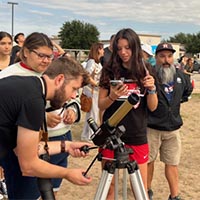
Contact: Maria Kazachenko
Institution: University of Colorado, Boulder
We will be sharing the joy of solar science and eclipses with local communities before and during the eclipse on the US-Mexico border in Del Rio and Eagle Pass, TX.

Contact: Hugh Hudson
Institution: University of Glasgow
The SunSketcher.org project provides a free app to allow smartphone users to help capture the precise timing of Baily's Beads. This will define the detailed shape of the solar disc by using the Moon as an astrometric reference, and it benefits from massive oversampling. The app runs automatically and uploads its images to a central server; all the user has to do is aim the back camera approximately towards the Sun a few minutes before second contact, and after the eclipse to approve of the upload.
Contact: see page linked to in title
Institution: see page linked to in title
The American Astronomical Society (AAS) Solar Eclipse Task Force invited proposals for small grants to fund programs, activities, and events that will engage the public with the April 8, 2024, solar eclipse across North America. Priority has been given to programs specifically designed to engage meaningfully in eclipse education, outreach, and science activities with under-represented groups (URGs, including women/girls, ethnic minorities, and people with physical and/or mental disabilities) who often don't imagine themselves in science careers or who believe that science is “not for them”. After review and ranking by a committee of task-force members, 35 organizations/institutions and principal investigators (PIs) have been awarded mini-grants. For a complete list of projects, their description, and PI contact information visit https://eclipse.aas.org/mini-grants/awardees-projects.